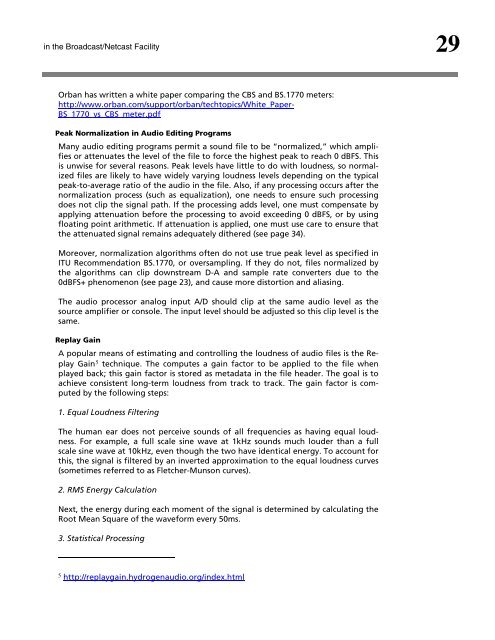Maintaining Audio Quality in the Broadcast Facility 2011 - Orban
Maintaining Audio Quality in the Broadcast Facility 2011 - Orban
Maintaining Audio Quality in the Broadcast Facility 2011 - Orban
Create successful ePaper yourself
Turn your PDF publications into a flip-book with our unique Google optimized e-Paper software.
<strong>in</strong> <strong>the</strong> <strong>Broadcast</strong>/Netcast <strong>Facility</strong> 29<br />
<strong>Orban</strong> has written a white paper compar<strong>in</strong>g <strong>the</strong> CBS and BS.1770 meters:<br />
http://www.orban.com/support/orban/techtopics/White_Paper-<br />
BS_1770_vs_CBS_meter.pdf<br />
Peak Normalization <strong>in</strong> <strong>Audio</strong> Edit<strong>in</strong>g Programs<br />
Many audio edit<strong>in</strong>g programs permit a sound file to be “normalized,” which amplifies<br />
or attenuates <strong>the</strong> level of <strong>the</strong> file to force <strong>the</strong> highest peak to reach 0 dBFS. This<br />
is unwise for several reasons. Peak levels have little to do with loudness, so normalized<br />
files are likely to have widely vary<strong>in</strong>g loudness levels depend<strong>in</strong>g on <strong>the</strong> typical<br />
peak-to-average ratio of <strong>the</strong> audio <strong>in</strong> <strong>the</strong> file. Also, if any process<strong>in</strong>g occurs after <strong>the</strong><br />
normalization process (such as equalization), one needs to ensure such process<strong>in</strong>g<br />
does not clip <strong>the</strong> signal path. If <strong>the</strong> process<strong>in</strong>g adds level, one must compensate by<br />
apply<strong>in</strong>g attenuation before <strong>the</strong> process<strong>in</strong>g to avoid exceed<strong>in</strong>g 0 dBFS, or by us<strong>in</strong>g<br />
float<strong>in</strong>g po<strong>in</strong>t arithmetic. If attenuation is applied, one must use care to ensure that<br />
<strong>the</strong> attenuated signal rema<strong>in</strong>s adequately di<strong>the</strong>red (see page 34).<br />
Moreover, normalization algorithms often do not use true peak level as specified <strong>in</strong><br />
ITU Recommendation BS.1770, or oversampl<strong>in</strong>g. If <strong>the</strong>y do not, files normalized by<br />
<strong>the</strong> algorithms can clip downstream D-A and sample rate converters due to <strong>the</strong><br />
0dBFS+ phenomenon (see page 23), and cause more distortion and alias<strong>in</strong>g.<br />
The audio processor analog <strong>in</strong>put A/D should clip at <strong>the</strong> same audio level as <strong>the</strong><br />
source amplifier or console. The <strong>in</strong>put level should be adjusted so this clip level is <strong>the</strong><br />
same.<br />
Replay Ga<strong>in</strong><br />
A popular means of estimat<strong>in</strong>g and controll<strong>in</strong>g <strong>the</strong> loudness of audio files is <strong>the</strong> Replay<br />
Ga<strong>in</strong> 5 technique. The computes a ga<strong>in</strong> factor to be applied to <strong>the</strong> file when<br />
played back; this ga<strong>in</strong> factor is stored as metadata <strong>in</strong> <strong>the</strong> file header. The goal is to<br />
achieve consistent long-term loudness from track to track. The ga<strong>in</strong> factor is computed<br />
by <strong>the</strong> follow<strong>in</strong>g steps:<br />
1. Equal Loudness Filter<strong>in</strong>g<br />
The human ear does not perceive sounds of all frequencies as hav<strong>in</strong>g equal loudness.<br />
For example, a full scale s<strong>in</strong>e wave at 1kHz sounds much louder than a full<br />
scale s<strong>in</strong>e wave at 10kHz, even though <strong>the</strong> two have identical energy. To account for<br />
this, <strong>the</strong> signal is filtered by an <strong>in</strong>verted approximation to <strong>the</strong> equal loudness curves<br />
(sometimes referred to as Fletcher-Munson curves).<br />
2. RMS Energy Calculation<br />
Next, <strong>the</strong> energy dur<strong>in</strong>g each moment of <strong>the</strong> signal is determ<strong>in</strong>ed by calculat<strong>in</strong>g <strong>the</strong><br />
Root Mean Square of <strong>the</strong> waveform every 50ms.<br />
3. Statistical Process<strong>in</strong>g<br />
5 http://replayga<strong>in</strong>.hydrogenaudio.org/<strong>in</strong>dex.html



![[PDF] Using the ITU BS.1770-2 and CBS Loudness Meters ... - Orban](https://img.yumpu.com/50629372/1/190x245/pdf-using-the-itu-bs1770-2-and-cbs-loudness-meters-orban.jpg?quality=85)






![[PDF] Optimod-FM Feature Comparison - Orban](https://img.yumpu.com/41741615/1/190x245/pdf-optimod-fm-feature-comparison-orban.jpg?quality=85)






